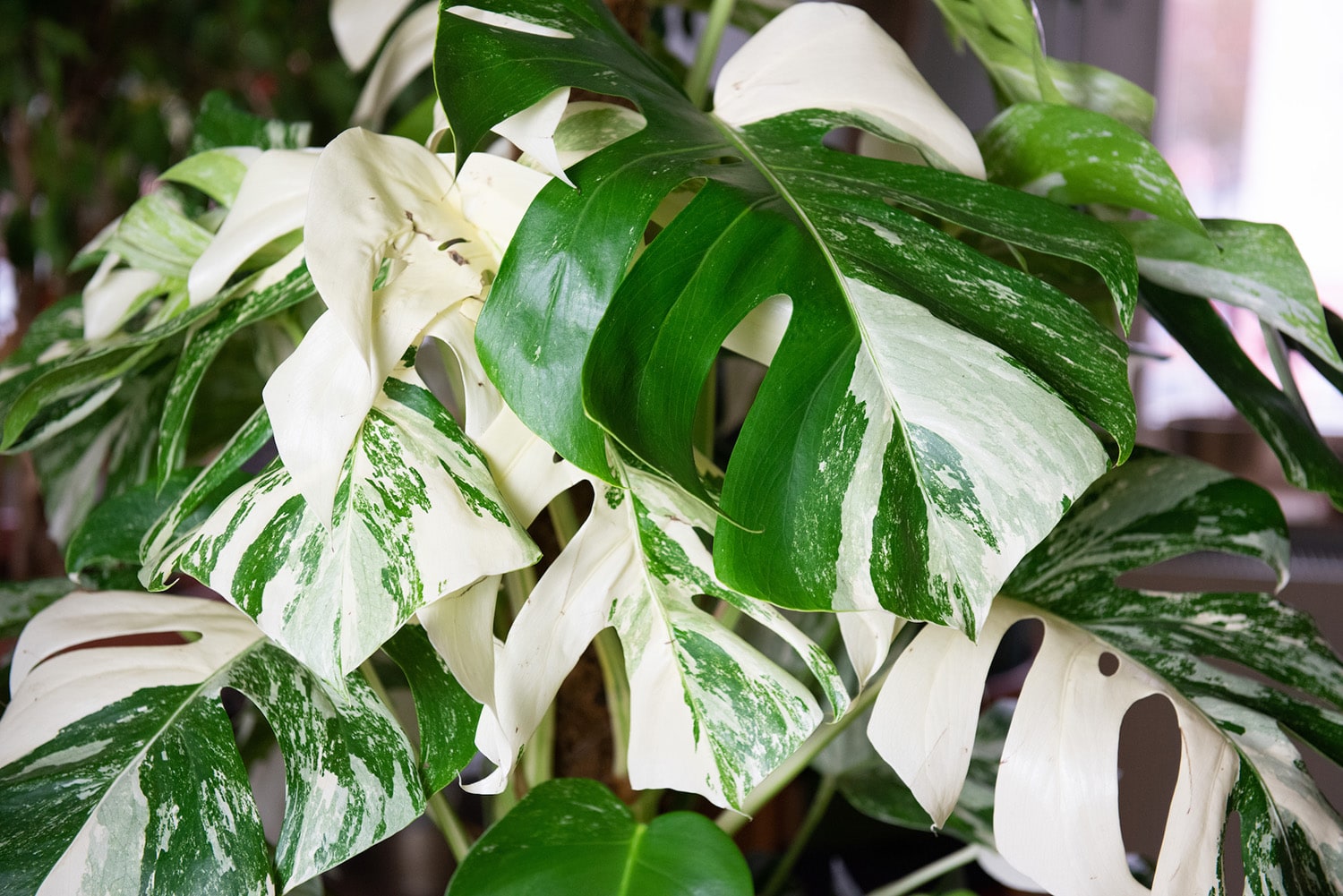What Is the Monstera Species? Your Ultimate Guide

What Is the Monstera Species? Your Ultimate Guide
A home filled with thriving plants is a happy one. The lush green leaves filling spaces in your home create a warmth that you can’t get from hanging a picture or turning a lamp.
The Monstera species of plants are prolific growers, both indoors and in the jungle and make for a perfect addition to your decor.
Are you wondering if a monster can survive your green thumb? What does it take to keep a Monstera alive?
With so many species of the Monstera plant, there’s one that’s perfect for you. Read on to learn all there is to know about the Monstera species of plants and hear about some of the many varieties too.

Get to Know Monstera
The Monstera plant and its many varieties are popular choices for the home. Often confused with the Split-Leaf Philodendron, the Monstera has many varieties. The Monstera comes from the Araceae family which in Latin means abnormal. While this plant isn’t a weird one, it does fit the bill in how it grows.
The Monstera, often called the swiss cheese plant, has big shiny, dark green leaves. These leaves grow with irregular loops on the leaves, one of the reasons it’s often confused with Split-Leaf Philodendron. However, the way to distinguish the Monstera is with the holes also found on the leaves, giving it the look of a piece of Swiss cheese. It has also been called the mother-in-laws tongue.
While Monsteras are great growers inside as houseplants, they are prolific in the jungle. They can grow and climb to dozens of feet tall. Some single leaves can even get as big as several feet wide.
Inside the Monstera plant likes lots of space to spread and grow. It will often send out shoots with its leaves going in all directions. If your indoor plant is getting big or unruly, don’t be afraid to cut a leaf and throw it in a vase. In fact, the leaves last well in water for a long period of time.
This might also be the reason the Monstera has surged in popularity in the interior design world. Now you see the big leaf of the Monstera plant on fabric, wallpaper and in art prints.
How to Grow a Monstera
While in the jungle the Monstera adapts itself in unusual ways to get to the light. Inside, the success for Monstera depends on getting it light but not too much.
It likes bright light but not direct sun. If the plant gets too much light, you’ll see the leaves turning yellow. If it doesn’t get enough light, the plant does this unusual thing where its leaves grow towards the dark. This is something it also does in the jungle as it looks for bigger plants to climb on to get towards the sun.
The plant doesn’t like too much water. Let it dry out between waterings. Most of the time a weekly watering for an inside Monstera works well.
If you want to control how big your Monstera grows, don’t re-pot it. When it has more room, it will grow bigger. You can also prune new growth to control its size.

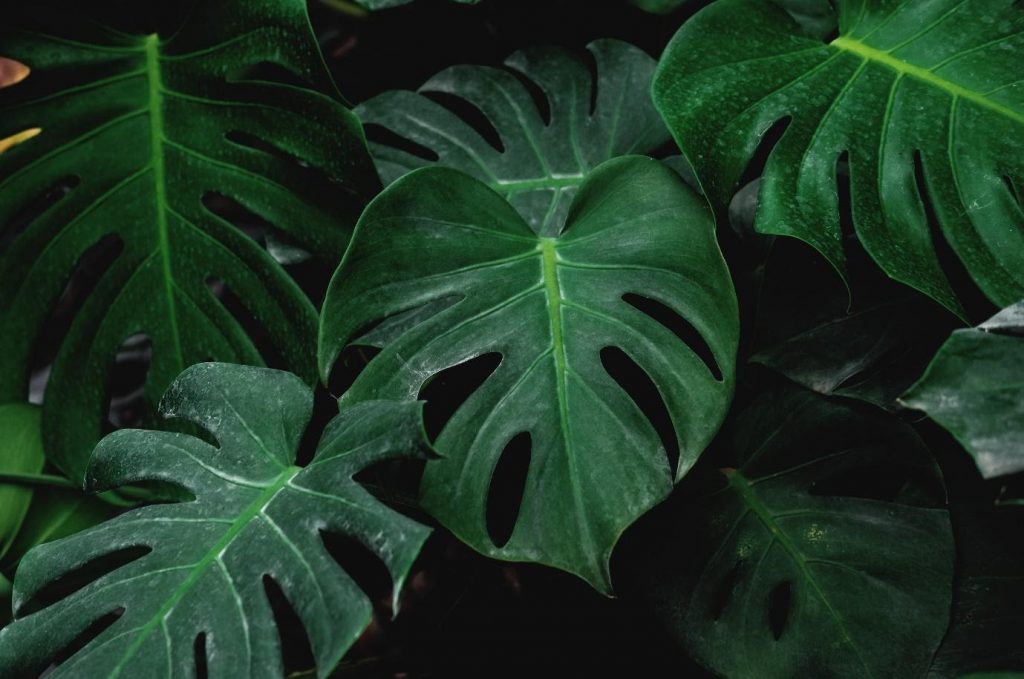
Monstera Leaves
There are many theories about why the Monstera has holes in the leaves giving it the moniker swiss cheese plant.
Since the leaves grow so big, some scientists speculate the perforations found on the leaves increase surface area. This makes it easier for the plant to capture the sunlight.
Others speculate the holes in the leaves allow water to not sit on the leaves when there is heavy rain. This keeps the leaves and plant from rotting or facing disease.
There are some theories that holes in the leaves allow wind to get through the big leaves and prevent damage to the plant. Other scientists have theorized that the holes were adapted in the jungle so the water from rain could pass through the massive leaves and get to the roots of the plant.
Monstera Varieties
The Monstera plant comes in many varieties, some more common than others. Let’s take a closer look at some of the different varieties.
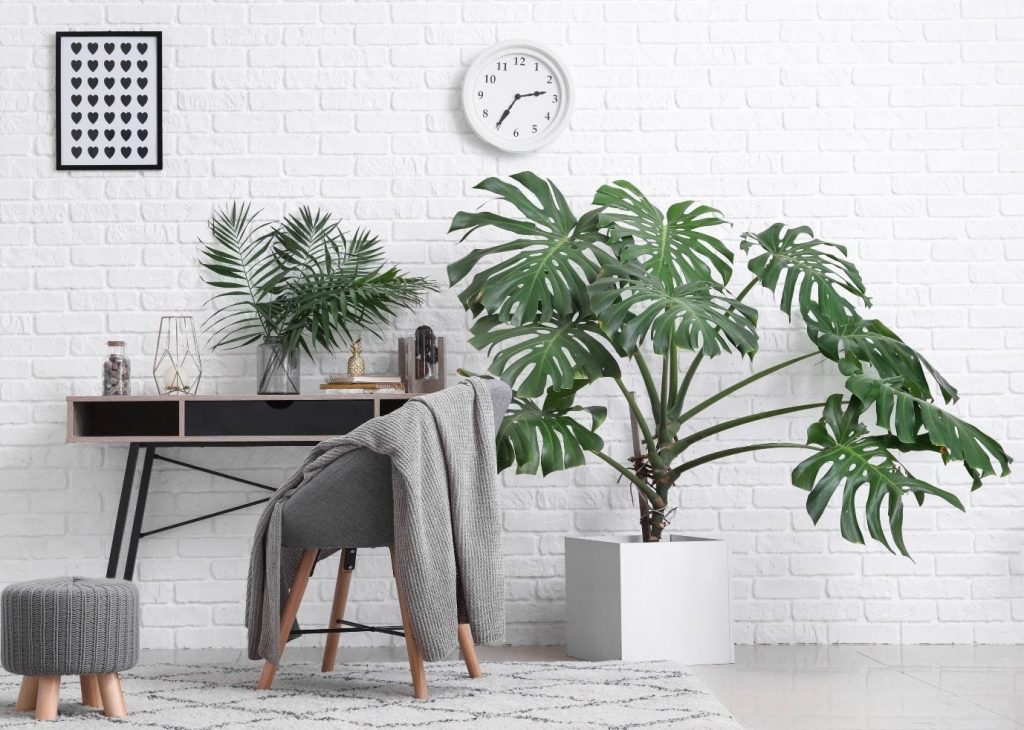
Monstera Deliciosa
The Monstera Deliciosa is the most commonly known of the Monstera varieties. It’s the variety having quite a renaissance in the decor world right now.
The Deliciosa is the variety you are likely to find when you go to buy one as a houseplant. It features the signature big, green, glossy leaves full of the big loops that it’s known for.
In the jungle, the Monstera Deliciosa can also grow fruit. It is sometimes referred to as the Mexican Breadfruit plant. The plant can produce fruit shaped like a corncob. It’s said to have a tropical taste, somehow combining pineapple, banana and mango into one flavour profile.
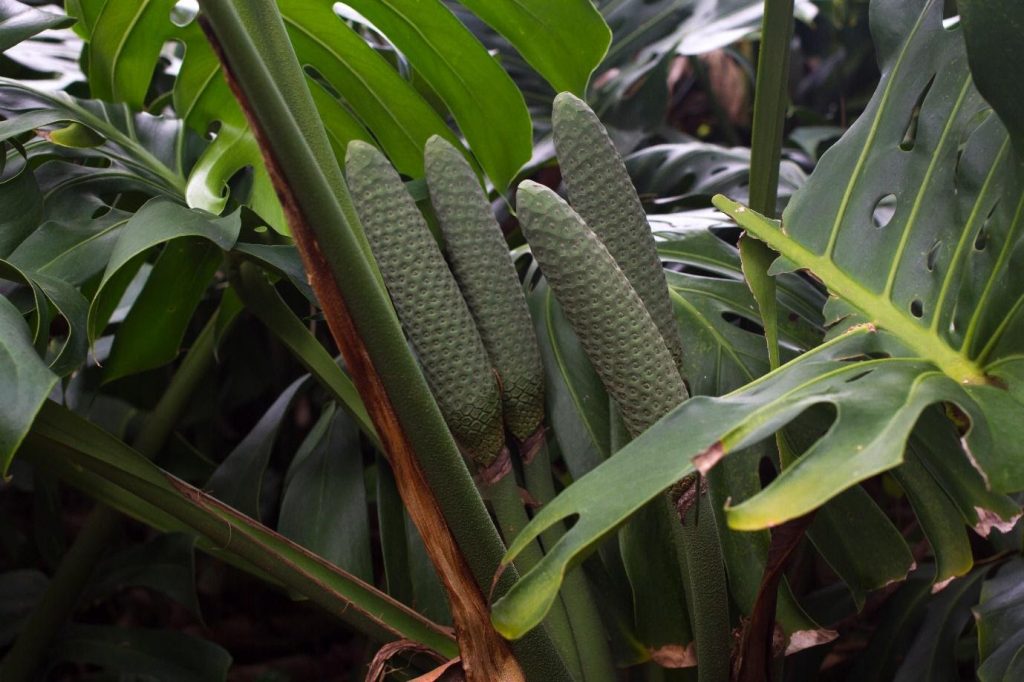
While you can eat the fruit, you should know the Monstera Deliciosa can be toxic to both humans and animals. If you have a pet who on occasion will eat at plants, you want to keep the Monstera Deliciosa out of reach. If ingested it can cause throat swelling and burning and vomiting.
Monstera Borsigiana
Some might like to call this the Deliciosa’s twin because of their very close similarities. Both the Deliciosa and the Borsigiana look remarkably similar as young plants. Some nurseries will even call them the same things, identifying them as simply Monsteras.
There is a way to tell if you actually have Deliciosa or a Borsigiana. Look closely at where the stem and the leaves meet up. Study the stems themselves for clues.
In a Deliciosa you will see the stems pucker, or form little bumps where the leaf and stem meet. It almost gives the appearance of a small ruffle. TheBorsigiana does not have the same pucker or ruffle feature.
The Borsigiana plant tends to grow somewhat smaller than the Deliciosa too. The holes on the leaves of the Borsigiana tend to be tidier, showing up in rows instead of randomly like they might on the Deliciosa.
This variety requires the same growing conditions as the Deliciosa and grows much the same way which is why they are often confused with each other.
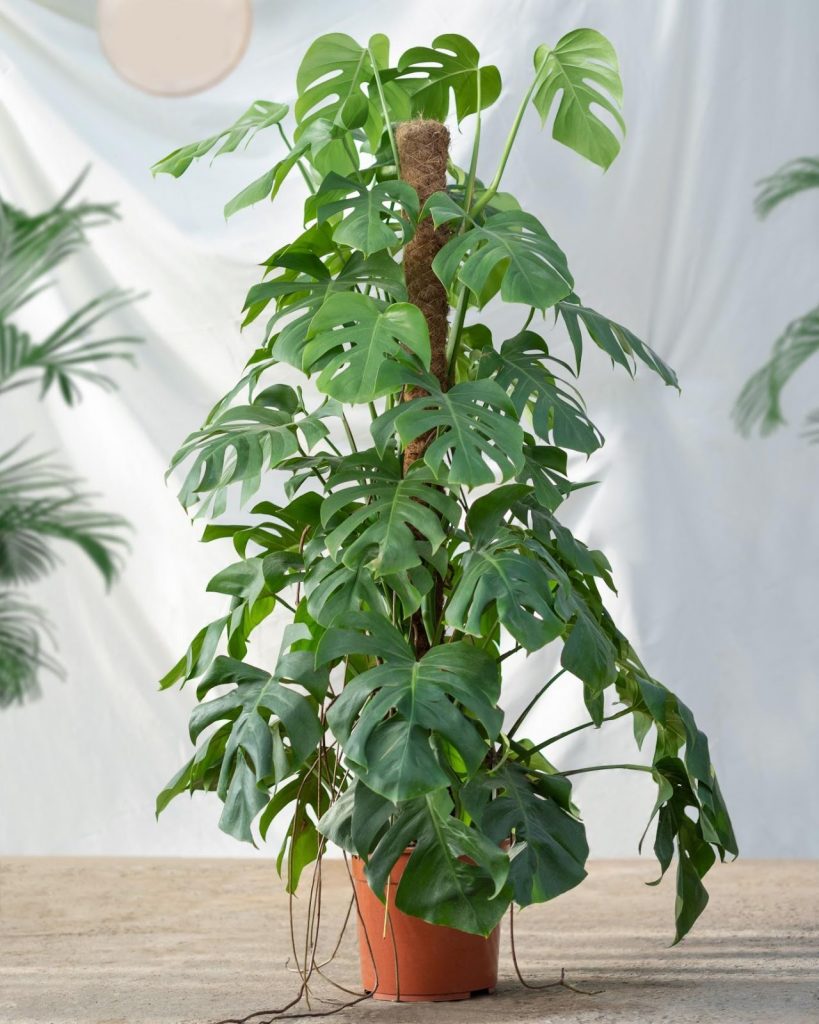
Monstera Variegata
While the Deliciosa likes to show off its leaves with shape and size, the Monstera Variegata takes it to a whole new level. This is not a different species of the Monstera, rather a variety.
In Latin the term Variegata means colour. And the Monstera Variegata brings it in the colour department. There is a mutation in the leaves of the plant that keeps them from turning green. So, instead of the striking shiny all green leaves, you see bold sections of white on the leaves too.
This unusual and rare mutation that happens in the leaves makes it challenging to propagate new plants, so it makes the Monstera Variegata even rarer and often expensive.
There are three main varieties of the Variegata to be aware of.
The Monstera Deliciosa var Albo Variegata features big white bold leaves and some variegated leaves too. Many of the leaves will have large sections of both white and green on them.
This variety is popular and rare which also makes it expensive.
The Monstera Deliciosa var Aura Variegata is equally rare as the Monstera Deliciosa var Albo Variegata, yet less well known. The feature of this plant is that instead of white on the leaves, it features variegated green and yellow leaves. Because of its rare nature, it can also be pricey.
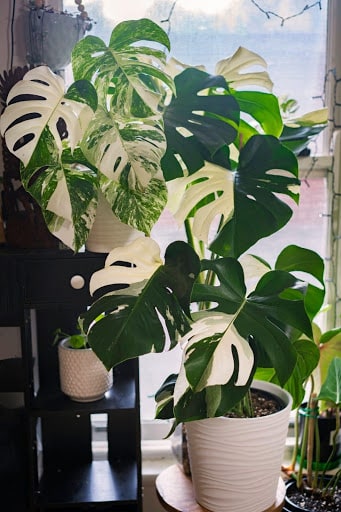
Photo by Duong Minh Le
Finally, the Monstera Deliciosa var Thai Constellation is another variety of Deliciosa. It more easily propagates, making it less rare. The leaves feature cream-coloured variegation. The cream-coloured areas show up both as big areas on the leaves and as random dots on this variety of plant.

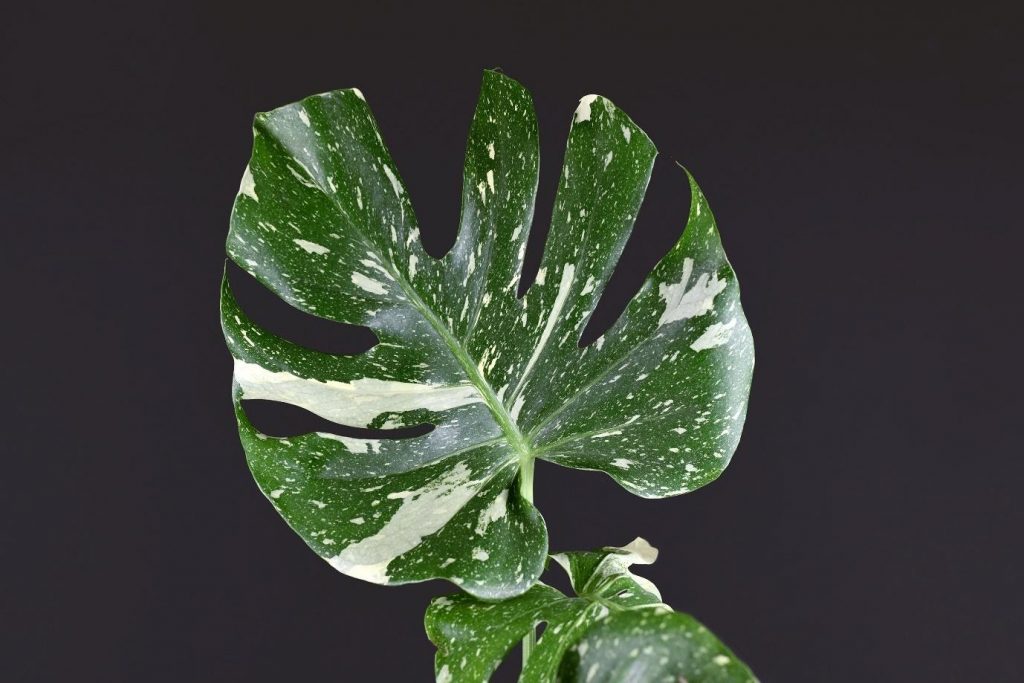
Monstera Borsigiana Variegata
The Monstera Borsigiana, similar to the Deliciosa also has variegated versions. They can come in both the white or Albo form or the yellow or Aura form.
These plants tend to variegate more willingly and pass on their variegation more consistently when propagated.
This makes the Monstera Borsigniana Variegata relatively easier to come across and significantly more popular. Nowadays, it has become a must-have household item for the plant enthusiast.

Photo by Duong Minh Le
Monstera Adansonii
Often confused with the Monstera Obliqua, the Monstera Adansonii is more common. If you find a plant in a houseplant seller labelled as a Monstera Obliqua chances are very good it’s the Adansonii instead.
The Monstera Adansonii is much more common and easy to find.
It has smaller leaves than the Deliciosa variety. The leaves also have more holes than the Deliciosa. The Monstera Adansonii also has leaves that are thicker and rougher than its look-alike the Obliqua.
This one also has a semi-official synonym of Monstera Friedrichtsthallii. The botanist who discovered and named the Monstera Adansonii found the plant a second time only he didn’t recognize. So the second time, he named it the Monstera Friedrichtsthallii. It was only later that it was discovered to be the same plant.

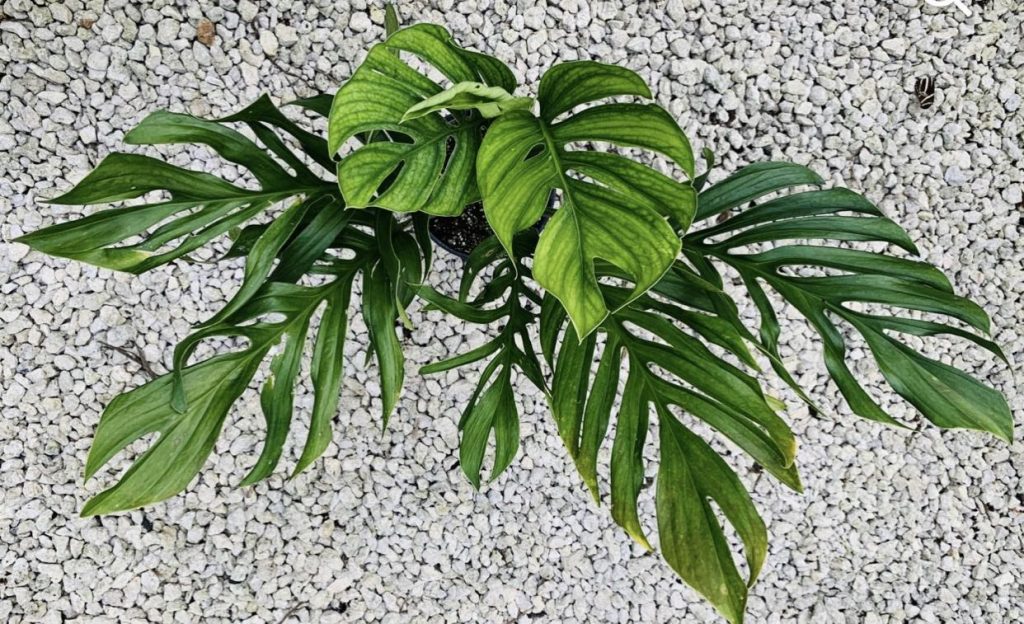
Photo by Enid Offolter NSE Tropicals
The Monstera Pinnatipartita is another Monstera species that is rare in Australia. Its name is derived from the Latin word partitus which means divided into parts.
The Monstera Pinnatipartita is another showstopper for its leaves. They grow very large. The glossy leaves feature a deep emerald green colour and are somewhat leathery in texture. Instead of the holes that you see in the Deliciosa, the Pinnatipartita grows with slits in the leaves. This plant is also known for its beautiful, pure white, and waxy flowers.
It’s not likely one you’ll find in a nursery or with a brick and mortar house plant seller. To find the Pinnatipartita variety, you’ll likely need to seek out an online source.
Monstera Pinnatipartita
Monstera Dubia
While the Monstera Dubia is in the Monstera species, it’s one that looks quite different from the other species mentioned here. The Monstera Dubia has small heart-shaped leaves unlike its relatives with the big glossy irregular leaves.
Their colouring is different too. Instead of the dark glossy leaves, the Monstera Dubia has leaves with both light and dark green. This is not a variegated variety, but the mix of light green and dark green almost give the appearance of variegation.
The variety also has shorter stems with close-growing leaves. The Dubia grows more vine-like and will climb whatever it is near.
One of the most fascinating facts about this plant is that when the Dubia gets to full maturity in the wild, a transformation takes place whereby fenestrations start to appear on the leaves, making the plant almost unrecognisable as a Dubia. However this is a rare occurrence and it will most likely not occur as an indoor plant.
If you see one of the Monstera Dubia available, you should grab it as this another rare variety from the Monstera family in Australia.


Monstera Siltepecana
Monstera siltepecana is an appressed epiphyte, meaning it’s a type of shingle plant that closely “hug” the host tree and grows as a climbing vine.
The juvenile specimens of Monstera siltepecana has bluish green leaves with silvers markings. Similar to the Dubia, as the Siltepecana begins to mature it morphs into a plant that looks quite different than its younger self.
When it reaches to full maturity the plant has large fenestrated leaves shaped like a teardrop, however instead of holes all over the leaves, they appear more around the centre part of the leaf’s vein. The Siltepecana also tends to be lighter in colour than some other Monstera varieties and the leaf blades are somewhat leathery.
This is another rarity in Australia of the Monstera genus so if you find this plant available you should grab it.
Monstera Obliqua
Photo by Enid Offolter NSE Tropicals
Okay, you aren’t likely to ever see one of the Monstera Obliqua unless you visit a well-planted botanical garden. But it is a variety of Monstera so it should be mentioned. This variety has only been found 17 times in natural habitats. Often the plant is researched for cross-breeding with other Monstera varieties.
The Monstera Obliqua has paper-thin delicate leaves. Aside from the fragileness of the leaves, which makes them truly unique is that there are more holes in the leaves than actual leafy material.
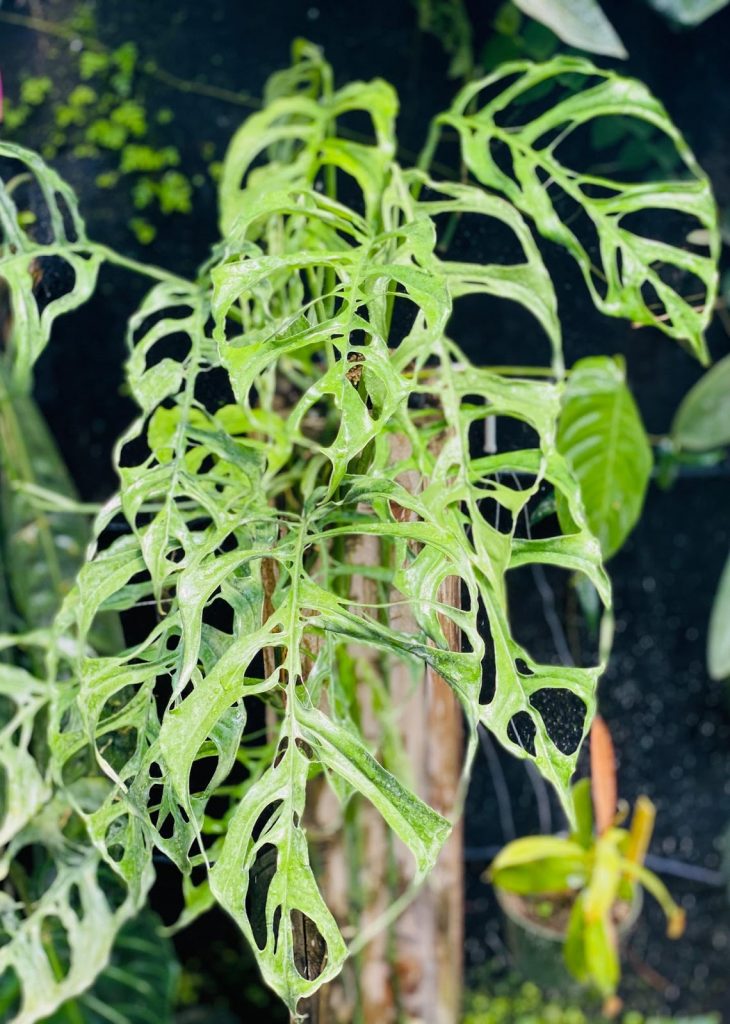
Know All About the Monstera Species
It’s not hard to see why the Monstera, specifically the Monstera Deliciosa is such a popular plant to use in both interior and outside spaces. The big green glossy leaves are good growers and are statement-makers too.
The Monstera species of plants are each unique with their big holey leaves and sprawling shape. Don’t you want one for your home too?
For more plant information on

Monstera Warning Label
While the Monstera varieties, especially the Monstera Deliciosa and the Monstera Adansonii, are very popular and often used as houseplants in the home, they should come with a warning label.
Sure, you can eat the breadfruit from the Deliciosa, yet the leaves and stems on the Monstera plants can be highly toxic. The toxic effects can hurt both humans and pets.
If you have a Monstera in your home along with children or pets, you want to put them in a location where you know they can’t be reached for safety reasons.

